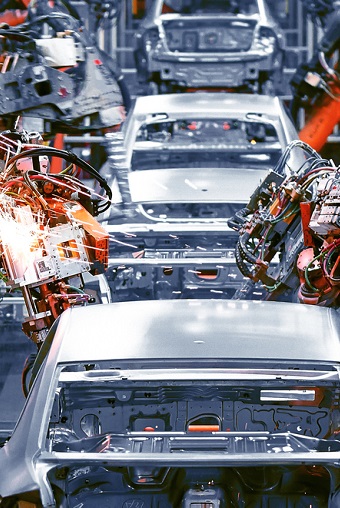Key Findings:
A complete market research report, including forecasts and market estimates, technologies analysis and developments at innovative firms within the Manufacturing, Automation & Robotics Industry. Gain vital insights that can help shape strategy for business development, product development and investments.
Key Features:
-
Business trends analysis
-
In-depth industry overview
-
Technology trends analysis
-
Forecasts
-
Spending, investment, and consumption discussions
-
In-depth industry statistics and metrics
-
Industry employment numbers
Additional Key Features Include:
Industry Glossary
Industry Contacts list, including Professional Societies and Industry Associations
Profiles of industry-leading companies
-
U.S. and Global Firms
-
Publicly held, Private and Subsidiaries
-
Executive Contacts
-
Revenues
-
For Public Companies: Detailed Financial Summaries
-
Statistical Tables
Key Questions Answered Include:
-
How is the industry evolving?
-
How is the industry being shaped by new technologies?
-
How is demand growing in emerging markets and mature economies?
-
What is the size of the market now and in the future?
-
What are the financial results of the leading companies?
-
What are the names and titles of top executives?
-
What are the top companies and what are their revenues?
This feature-rich report covers competitive intelligence, market research and business analysis—everything you need to know about the Manufacturing, Automation & Robotics Industry.
Plunkett Research Provides Unique Analysis of the Following Major Trends Affecting the Manufacturing, Automation & Robotics Industry
-
Major Trends Affecting the Manufacturing, Automation & Robotics Industry
-
Introduction to the Manufacturing, Automation & Robotics Industry
-
Industrial Robots and Factory Automation Advance Through Artificial Intelligence (AI)
-
Humanoid Robots/Service Robots Are Boosting Efficiencies in Warehouses and More
-
Tariffs Impact Manufacturing of All Types/Imports from the EU, China, Mexico and India Affected
-
U.S. Electric Vehicle (EV) Subsidies Expire in 2025/U.S. Auto Manufacturers Change Strategies
-
Global Growth in Manufacturing and Trade Require Investment by Emerging Nations
-
Introduction to the Outsourcing & Offshoring Industry
-
Pros and Cons of Outsourcing & Offshoring
-
Nearshoring and Reshoring Keep Operations Closer to Home
-
U.S. Apparel and Textile Jobs Reshore to Some Extent
-
Vietnam, India and Other Countries Gain Manufacturing Market Share/Tariffs Alter Market Significantly
-
The Vast Majority of Shoes Sold in the U.S. Are Made Elsewhere
-
3-D Printing and Robotics Revolutionize Manufacture of Shoes and Fabrics
-
Original Design Manufacturing (ODM) Adds Value to Contract Electronics Manufacturing
-
Trends in Manufacturing, such as Original Design Manufacturers (ODMs), Lead to Collaboration and Consulting-Like Services
-
3D Printing (Additive Manufacturing), Rapid Prototyping and Computer Aided Design
-
3PL Logistics Services and Supply Chain Management Services Evolve and Consolidate
-
Manufacturers Focus on High Performance Plastics and Specialty Chemicals
-
Refineries Along with Chemicals and Plastics Plants Expand in the U.S.
-
Telecom Equipment Makers Face Intense Competition from Manufacturers in China
-
Boeing and Airbus Compete for New Orders
-
U.S. Auto Manufacturers Ford, Stellantis and GM Compete Head-On with Foreign Manufacturers
-
India Has a Significant Automobile Market, with Great Long-Term Potential
-
Mexico Is a Leading Automotive Maker and Exporter
-
Designers and Manufacturers Bypass the Middleman with Direct-to-Consumer Online Business Models
-
Artificial Intelligence (AI), Deep Learning and Machine Learning Advance into Commercial Applications, Including Health Care and Robotics
-
The Internet of Things (IoT) in Factories, Robotics and Equipment
-
Health Care Robotics
-
Robotics in Retailing and Ecommerce Fulfillment
Plunkett Research Provides In-Depth Tables for the Following Manufacturing, Automation & Robotics Industry Statistics
I. Overview of the Manufacturing, Automation & Robotics Industry
-
Manufacturing, Automation & Robotics Industry Statistics and Market Size Overview
-
Sales & Net Income After-Tax, U.S. Manufacturing Corporations: 2016- 1st Quarter 2025
-
Sales & Operating Profits, U.S. Manufacturing Corporations, by Industry: 1st Quarter 2024- 1st Quarter 2025
II. Output & Employment
-
Value Added to U.S. Economy by Manufacturing Sector, as a Percentage of GDP: 1997-2024
-
Employment in the U.S. Manufacturing Sector, as a Percentage of all Private Industry Employment: 1950 – July 2025
-
Employment in the U.S. Manufacturing Sector, by Industry: 2019 – July 2025
-
Manufacturing Output vs. Employment, U.S.: 1980- June 2025
-
Gross Output in the Wood & Nonmetallic Mineral Products Manufacturing Industries: Selected Years, 2018-2023
-
Gross Output in the Primary Metals & Fabricated Metal Products Manufacturing Industries: Selected Years, 2018-2023
-
Gross Output in the Machinery Manufacturing Industry, U.S.: Selected Years, 2018-2023
-
Gross Output in the Computer & Electronic Product Manufacturing Industries: Selected Years, 2018-2023
-
Gross Output in the Electrical Equipment, Appliances & Components Manufacturing Industries: Selected Years, 2018-2023
-
Gross Output in the Motor Vehicles & Transportation Equipment Manufacturing Industries: Selected Years, 2017-2023
-
Gross Output in the Food, Beverage & Tobacco Product Manufacturing Industries, U.S.: Selected Years, 2018-2023
-
Gross Output in the Textile & Apparel Manufacturing Industries, U.S.: Selected Years, 2018-2023
-
Gross Output in the Chemicals, Plastics & Rubber Products Manufacturing Industries, U.S.: Selected Years, 2018-2023
III. Shipments
-
Annual Value of Manufacturers’ Shipments for Industry Groups, U.S.: 2018-2024
IV. Exports
-
Value of Exports of All Manufactured Goods, U.S.: 2018 – 2024
-
Exports of Durable & Nondurable Manufactured Goods, U.S.: 2018 – 2024
-
Value of Exports of U.S. Vehicles: 2019-2024
-
Exports, Imports & Trade Balance of Computers & Electronic Products, U.S.: 2018-2024
-
Exports, Imports & Trade Balance of Chemicals, U.S.: 2018 – 2024
-
Top 50 Destinations of U.S. Textiles & Apparel Exports: 2023-2024
-
Top Ten Suppliers & Destinations of U.S. Computers & Electronic Products: 2018- 2024




















